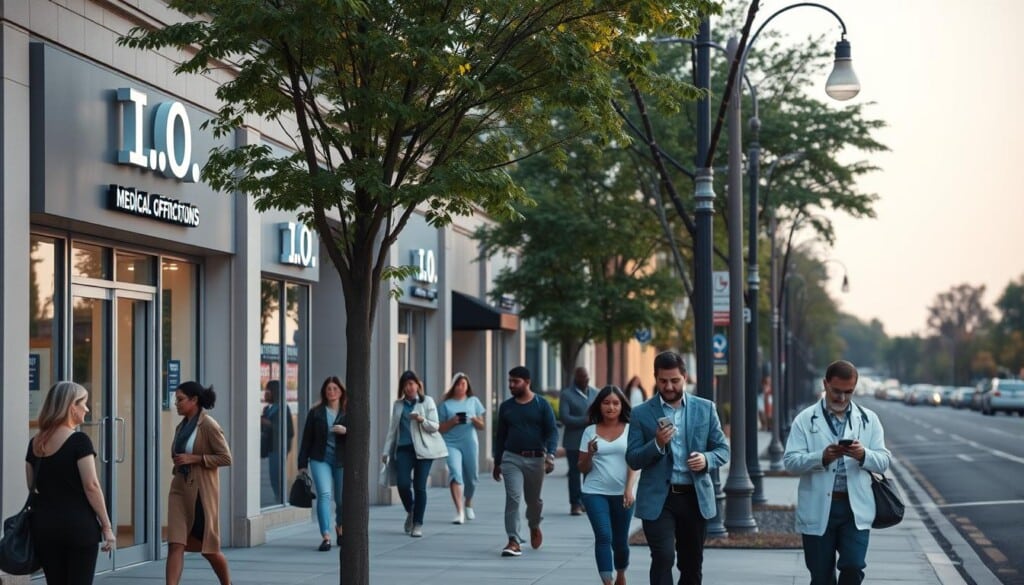Have you ever thought about how your body’s systems work together? This is at the core of Osteopathic medicine. It’s a holistic approach that Osteopathic Physicians, or D.O. doctors, follow. Started in 1874, it looks at the body, mind, and spirit as a whole for treatment.
D.O. doctors are fully licensed to treat many health issues. They play a big role in the U.S. medical field. As healthcare changes, knowing about Osteopathic medicine can make patient care better.
Key Takeaways
- Osteopathic Physicians focus on holistic healing and the interrelationship of body systems.
- D.O. doctors are fully licensed to practice medicine across multiple specialties.
- Understanding Osteopathic medicine can improve patient engagement.
- Preventative care is a significant aspect of the treatment offered by D.O. doctors.
- Founded by Dr. A. T. Stills in 1874, Osteopathic medicine continues to evolve within the healthcare system.
What Are Osteopathic Physicians?
Osteopathic physicians take a holistic approach to healthcare. They see the body, mind, and spirit as connected. This helps them focus on overall wellness, not just symptoms.
The Philosophy of Osteopathy
The osteopathy philosophy believes in the body’s healing powers. It looks at health in a big picture way. This includes lifestyle and emotions. It makes care more personal for each patient.
Differences Between DOs and MDs
D.O.s and M.D.s both get a lot of education. But D.O.s learn more about Osteopathic Manipulative Treatment (OMT). This lets them use hands-on methods to fix health problems.
Both can write prescriptions and do surgeries. But D.O.s often focus on preventing problems. This makes them understand health in a more complete way.
Holistic Approach to Health
Osteopathic medicine focuses on the whole person, not just symptoms. It aims to keep people healthy and well. This approach helps patients stay healthy for a long time.
Emphasis on Preventative Care
Preventative care is key in Osteopathic medicine. Doctors help patients make healthy lifestyle choices. They also do regular check-ups and wellness programs.
This helps prevent chronic diseases. It keeps people in top health.
Treatment of the Whole Person
Osteopathic medicine treats the whole person, not just symptoms. It looks at how physical, emotional, and environmental factors affect health. This way, treatment plans are made to help the person fully recover.

Common Conditions Treated by Osteopathic Physicians
Osteopathic physicians are great at treating many conditions, mainly musculoskeletal issues. They help with arthritis, sports injuries, and chronic joint pain. Their goal is to ease pain and improve movement, helping you move better and feel better.
Musculoskeletal Issues
Musculoskeletal problems often cause chronic pain, which can really affect your life. Osteopathic doctors look at the whole body to find the best ways to manage these issues. They use hands-on methods to reduce tension and improve how your body works, making you feel more stable and healthy.
Chronic Pain Management
For those dealing with chronic pain, osteopathic treatments offer non-invasive solutions. They create care plans that address both symptoms and the underlying causes of pain. This approach helps in healing and encourages patients to take an active role in their health. If you need help, you can contact your local osteopathic practice through support channels.
Benefits of Choosing an Osteopathic Physician
Choosing an Osteopathic Physician offers many benefits, mainly through personalized care. This focus is key because D.O.s aim to understand each patient’s unique health needs. They do this by conducting detailed evaluations to create treatments that fit each person’s situation.
Personalized Patient Care
The core of osteopathic benefits is personalized patient care. Osteopathic doctors look at lifestyle, environment, and mental health. This ensures patients get a complete approach to health.
This holistic view helps doctors understand health issues better. It leads to proactive and tailored solutions. These can result in better health outcomes for patients.
Comprehensive Treatment Plans
Osteopathic physicians are great at creating detailed treatment plans. These plans are flexible and change as needed. This flexibility helps care stay effective as patients progress.
As a result, patients often see big improvements in their life quality. This is thanks to osteopathic care’s focus on integration and holistic practices.

Osteopathic Manipulative Treatment (OMT)
Osteopathic Manipulative Treatment is a special way doctors use to help people get better. It involves different techniques to diagnose and treat illnesses. This method uses stretching, gentle pressure, and resistance to help with pain and improve movement.
OMT has been shown to help with headaches, back pain, and sports injuries. Studies have proven its effectiveness as a non-invasive option. It helps the body heal itself, aiming to relieve symptoms and boost overall health.
Integrating Osteopathic Care with Other Health Services
In today’s healthcare world, Osteopathic Physicians are key in teamwork. They work with many medical experts. This teamwork offers complete care that meets patients’ needs in many ways.
Collaboration with Other Medical Professionals
Osteopathic Physicians team up with physical therapists, nutritionists, and more. This team effort gives patients care that fits their health needs perfectly. Good communication among them makes treatment plans work better.
Enhancing Patient Outcomes
This team approach helps in tracking and changing treatment plans. It brings together different skills and methods for better care. Patients get a full view of their health, leading to better management of their conditions.
The Growing Demand for Osteopathic Physicians
The healthcare world is changing fast. More people want D.O.s for a complete health approach. They look for care that prevents problems, not just fixes them.
They want to feel better, not just be treated. This change shows a big shift in what patients want from doctors.
Trends in Patient Preferences
More people know about different healthcare options. They now want care that looks at the whole person. This means treating the body, mind, and spirit together.
This shift makes D.O.s very important. They offer care that fits with what patients want. This makes them stand out in the healthcare world.
The Future of Osteopathic Medicine
Osteopathy’s future looks bright. People are moving towards a more complete healthcare model. D.O.s are ready to meet this need with their focus on long-term health.
As more people seek D.O.s, these doctors will be key in shaping healthcare. They will help create better health practices for the future.
Finding Osteopathic Physicians in Your Area
Finding osteopathic physicians in your area is easy with LocalZ directory. This platform makes it simple to find D.O. doctors and access local health listings. You can read reviews and see what services each doctor offers.

Using LocalZ makes finding doctors easier and helps build community ties. It lets residents find D.O. doctors who care about their health and support local healthcare. This way, patients get top-notch care from doctors who are part of their community.
Engaging with Your Community
Community engagement is key for building strong ties between locals and healthcare providers. LocalZ is a major player in this area. It helps local businesses grow and makes medical services more accessible. They also support local economies by sharing a part of their fees with community groups.
With LocalZ, finding healthcare experts in your area is easy. This ensures you get top-notch care from people you trust. It also promotes teamwork among healthcare workers. This teamwork is vital for improving community health.
LocalZ’s work shows how important it is to connect with local healthcare providers. These connections improve healthcare access and make communities stronger. They help create a healthier public health environment for everyone.

